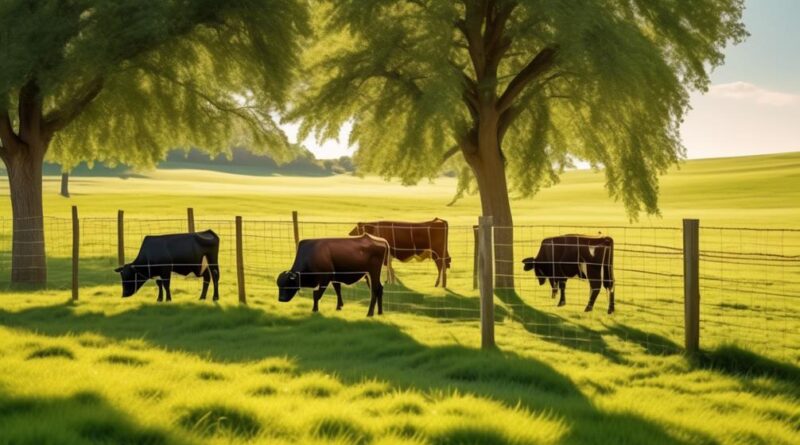5 Tips for Successful Intensive Rotational Grazing for Cattle
When it comes to intensive rotational grazing for cattle, it's like taking a page from the book of nature – constantly moving, adapting, and thriving.
You may think you've got the basics down, but there's always room for improvement in maximizing the productivity of your pastures and the health of your cattle.
Whether you're a seasoned grazier or just getting started, these five essential tips will help you fine-tune your approach and achieve success in your grazing management.
Grazing Management
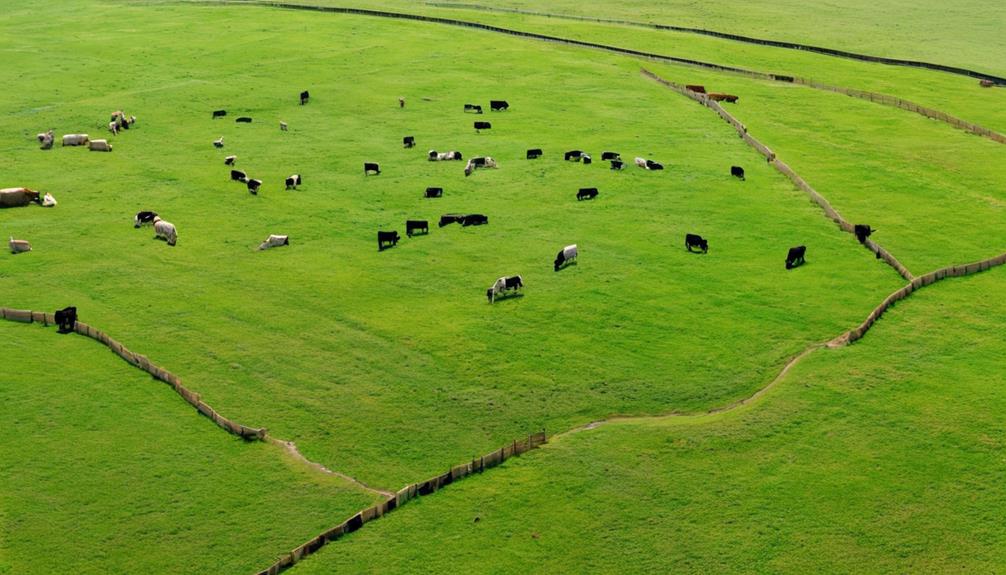
To effectively manage grazing, consider implementing intensive rotational grazing practices to optimize forage utilization and improve pasture health. Grazing behavior plays a crucial role in sustainable land use, and by adopting intensive rotational grazing, you can positively influence the behavior of your cattle and the health of your pastures.
Cattle naturally exhibit selective grazing behavior, preferring certain forages over others. Intensive rotational grazing allows you to manage this behavior by controlling the timing and duration of their access to different areas within the pasture.
By dividing your pasture into smaller paddocks and rotating the cattle through them frequently, you can encourage more uniform grazing. This prevents overgrazing in some areas while allowing forage in other sections to recover. The controlled grazing periods mimic the natural movement of wild herbivores, promoting healthier pastures and more sustainable land use. Additionally, this practice can lead to improved soil fertility and water infiltration, as well as reduced soil erosion.
Observing your cattle's grazing behavior within these smaller paddocks will also provide valuable insights into their forage preferences. This knowledge can inform future grazing management decisions and help you better understand how to maximize forage utilization. As a result, implementing intensive rotational grazing not only benefits pasture health but also enhances the overall productivity of your grazing operation.
Pasture Quality
Improving pasture quality can be achieved through effective grazing management practices, such as intensive rotational grazing. By employing proper grazing techniques, you can significantly enhance the forage available to your cattle and improve the overall health of your pastures.
Here are four key strategies to improve pasture quality:
- Optimal Stocking Density: Properly managing the number of cattle in a specific grazing area is crucial for maintaining pasture quality. Avoiding overgrazing and allowing for adequate rest periods for regrowth is essential. Rotating cattle to fresh paddocks frequently encourages more uniform grazing and prevents selective overgrazing, ultimately improving forage utilization.
- Enhanced Nutrient Distribution: Intensive rotational grazing helps in more even distribution of nutrients through manure and urine deposition. This helps in enriching the soil, promoting healthier and more robust forage growth.
- Weed Suppression: Intensive rotational grazing can effectively suppress the growth of undesirable weeds. By ensuring cattle graze all areas of the pasture, competition for resources is increased, thereby reducing the opportunity for invasive weed species to establish and spread.
- Increased Forage Production: Proper grazing management can lead to increased forage production. Through rotational grazing, where pastures are allowed to rest and recover, forage regrowth is stimulated, resulting in higher overall forage yield.
Implementing these strategies through intensive rotational grazing can significantly enhance the quality and quantity of forage available to your cattle, ultimately leading to improved pasture health and increased productivity.
Stocking Density
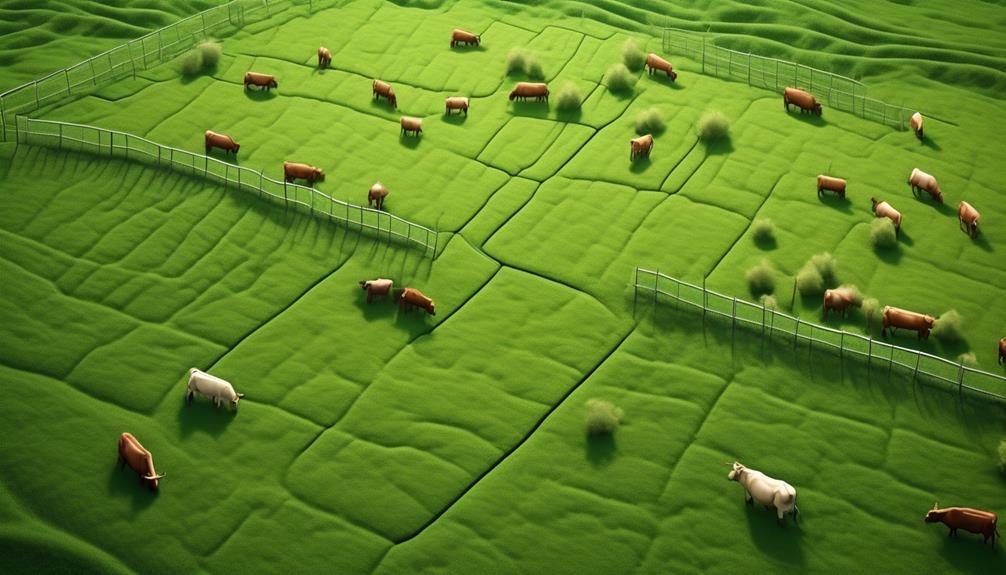
When managing stocking density in intensive rotational grazing, consider the optimal number of cattle for a specific grazing area to maintain pasture quality and encourage regrowth. Stocking density refers to the number of cattle in a specific area over a set period. It's crucial to strike a balance between maximizing the use of available forage and preventing overgrazing. Grazing pressure, which is the intensity and duration of grazing by livestock, should be carefully managed to avoid exceeding the carrying capacity of the pasture.
To determine the appropriate stocking density, assess the carrying capacity of the pasture. Carrying capacity is the maximum stocking density that a pasture can sustainably support without degrading its productivity. By matching the stocking density to the carrying capacity, you can ensure that the cattle have enough forage for proper nutrition while allowing the pasture to recover and regrow.
Overstocking can lead to excessive grazing pressure, resulting in the depletion of forage and damage to the pasture. On the other hand, understocking may lead to underutilization of available forage, reducing the efficiency of grazing. Therefore, it's essential to monitor the condition of the pasture regularly and adjust the stocking density as needed to maintain a balance between forage availability and grazing pressure.
Fencing and Water Access
Consider the placement of fencing and water access points to facilitate controlled grazing and efficient cattle movement within the grazing area. Proper fencing maintenance and water source optimization are crucial for the success of intensive rotational grazing.
Here are some key tips to ensure effective management of fencing and water access:
- Fencing Maintenance: Regularly inspect and maintain fencing to ensure it's secure and in good condition. This includes checking for loose wires, damaged posts, and ensuring that gates are functioning properly. Well-maintained fencing is essential for containing cattle within specific grazing areas and preventing them from accessing areas that need to be rested.
- Water Source Optimization: Strategically place water access points within each grazing area to ensure that cattle have easy and equitable access to water. Consider installing multiple water sources in larger grazing areas to minimize the distance cattle need to travel to access water. This helps to encourage even grazing distribution and reduces stress on the cattle.
- Strategic Placement: Design the grazing area layout to ensure that water access points are centrally located and easily accessible from all sections. This encourages cattle to evenly distribute themselves throughout the grazing area, preventing overgrazing in one area while leaving other areas underutilized.
- Consider Seasonal Needs: Take into account the seasonal variations in forage growth and water availability when planning the location of fencing and water access points. Ensure that these resources are strategically placed to accommodate the changing needs of the cattle throughout the year.
Monitoring and Rotational Schedule
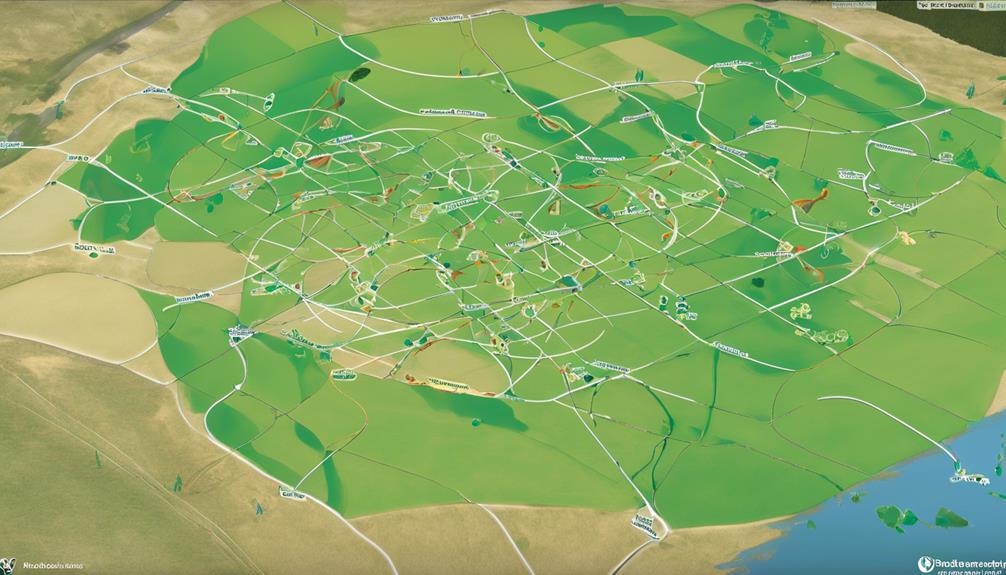
To effectively manage intensive rotational grazing for cattle, closely monitor their grazing behavior and establish a well-planned rotational schedule. Utilizing technology for remote monitoring can significantly enhance your ability to keep a close eye on your cattle's grazing patterns and overall well-being. By employing GPS tracking collars or remote cameras, you can observe how the cattle are utilizing the available pasture and whether they're exhibiting any unusual behaviors. This technology use enables you to make informed decisions about when it's time to rotate the herd to a new grazing area.
Remote monitoring also allows you to keep track of environmental factors such as weather conditions, which can impact the rotational schedule. By staying informed about the growth rate of the pasture and the environmental conditions, you can adjust your rotational schedule as needed to ensure that your cattle always have access to high-quality forage.
When establishing a rotational schedule, consider factors such as the carrying capacity of each grazing area, the recovery period needed for the pasture, and the nutritional needs of the cattle. By carefully planning the rotation, you can optimize forage utilization and maintain the overall health of the pasture.
Soil Health and Nutrient Management
Improving soil health and managing nutrients is essential for sustaining the productivity of grazing areas in intensive rotational grazing systems. By focusing on soil health and nutrient management, you can ensure that your grazing areas remain productive and sustainable for the long term.
Here are four key practices to prioritize for soil health and nutrient management:
- Soil Testing: Regular soil testing is crucial for understanding the nutrient levels and pH balance of your soil. By analyzing soil samples, you can make informed decisions about the types and quantities of fertilizers needed to maintain optimal soil fertility.
- Nutrient Cycling: Implementing rotational grazing helps in nutrient cycling. As cattle graze, they deposit organic matter onto the soil, which eventually decomposes and releases essential nutrients back into the soil. This natural process enhances soil fertility and reduces the reliance on external inputs.
- Erosion Control: Protecting the soil from erosion is vital for maintaining its health and productivity. Implementing best management practices such as contour plowing, planting cover crops, and establishing grassed waterways can help prevent soil erosion and preserve valuable topsoil.
- Organic Matter: Increasing organic matter in the soil is beneficial for overall soil health. Organic matter improves soil structure, moisture retention, and nutrient availability, creating a favorable environment for plant growth.
Forage Species Selection
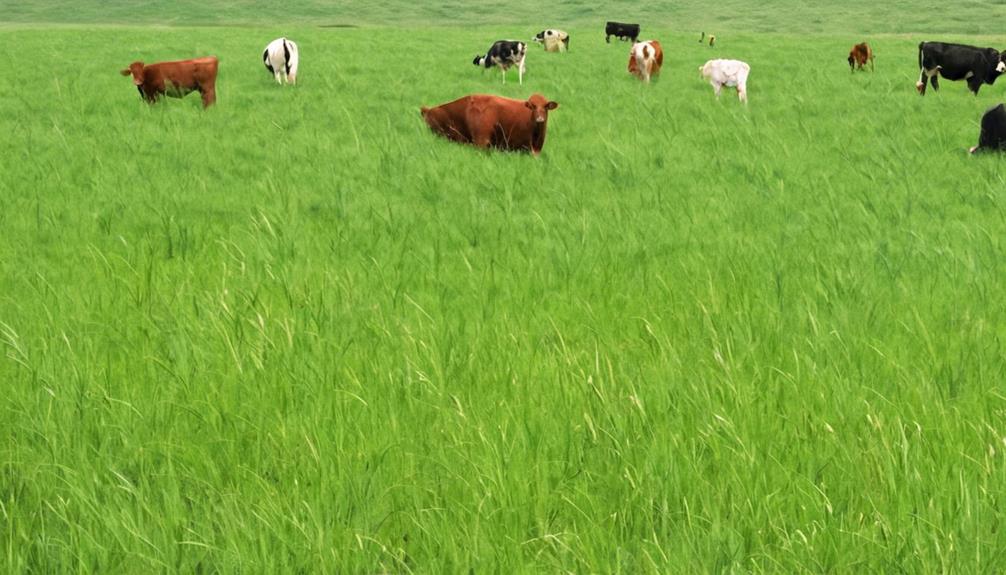
As you prioritize the health and productivity of your grazing areas through soil testing and nutrient cycling, the selection of forage species plays a crucial role in optimizing cattle nutrition and overall pasture performance. When choosing forage species, consider the seed variety that best suits your specific grazing goals and environmental conditions. Different seed varieties offer varying levels of drought tolerance, disease resistance, and nutrient content, so it's important to select the most suitable option for your rotational grazing system.
Understanding your cattle's grazing behavior is also essential in forage species selection. Some forage species are better suited to continuous grazing, while others thrive in rotational grazing systems. Consider the growth habits of different forage species and how they align with the intensity and timing of your grazing rotations. For example, some species are more resilient to frequent grazing and can quickly regenerate after being grazed, making them ideal for intensive rotational grazing.
Additionally, take into account the nutritional needs of your cattle when selecting forage species. Different forages offer varying levels of protein, energy, and fiber, so it's important to choose a diverse mix of species that can provide a well-rounded diet for your cattle throughout the grazing season.
Health and Parasite Control
You should regularly monitor the health of your cattle and implement effective parasite control measures to ensure the well-being and productivity of your herd. It's essential to prioritize the health of your cattle as part of your intensive rotational grazing practices. Here are some key points to consider:
- Parasite Resistance: Implement strategic grazing strategies to help reduce parasite loads on pasture. Rotational grazing, where cattle are moved frequently to new paddocks, can help break the parasite lifecycle by allowing pastures to rest and parasites to die off before cattle return to graze.
- Health Monitoring: Regularly observe your cattle for signs of poor health such as weight loss, diarrhea, or rough hair coats. Conducting routine fecal egg counts can help assess parasite burdens in your herd and inform your deworming schedule.
- Grazing Strategies: Utilize a combination of cattle grazing and other livestock, such as sheep or goats, to help control parasites. Different animal species can help lower the overall parasite burden on pastures through their varying grazing habits.
- Deworming Techniques: Work with your veterinarian to develop an effective deworming program tailored to your specific herd and grazing conditions. Utilize fecal egg counts to determine the most appropriate timing and products for deworming, while also being mindful of parasite resistance and the potential for developing resistant parasites.
Frequently Asked Questions
How Can I Minimize the Impact of Predators on My Grazing Cattle During Intensive Rotational Grazing?
To minimize the impact of predators on your grazing cattle during intensive rotational grazing, use predator deterrence and monitoring techniques. Implement livestock protection measures and proper grazing management to safeguard your herd.
What Are the Best Practices for Integrating Cattle Grazing With Other Agricultural Activities on the Same Land?
To integrate crops and livestock management techniques, plan grazing rotations to complement crop growth. Employing techniques like silvopasture or agroforestry can create a sustainable balance. Prioritize animal welfare and crop health for successful integration.
Are There Specific Considerations for Managing Intensive Rotational Grazing in Areas With Extreme Weather Conditions?
When managing intensive rotational grazing in areas with extreme weather, consider adapting to extreme heat and managing snow accumulation. Locate shade for cattle during hot weather and plan grazing rotations to minimize snow cover impact.
How Can I Effectively Manage and Prevent Weed Growth in Grazing Areas Without Using Harmful Chemicals?
To effectively manage and prevent weed growth in grazing areas without harmful chemicals, you can introduce natural predator control methods like goats or sheep to graze on weeds. Regular mowing and maintaining a healthy, dense pasture also helps.
What Are the Potential Benefits of Incorporating Alternative Forage Species Into My Cattle's Grazing Rotation, and How Can I Effectively Implement This?
Incorporating legume species into your cattle's grazing rotation can improve soil fertility and provide nutritional benefits. To implement this, select suitable legumes for your region, monitor grazing intensity, and rotate pastures effectively.
Conclusion
In conclusion, successful intensive rotational grazing for cattle requires careful grazing management, consideration of pasture quality, proper stocking density, fencing and water access, and regular monitoring.
It's also important to prioritize soil health and nutrient management, select appropriate forage species, and implement effective health and parasite control measures.
By following these tips, you can ensure the health and productivity of your cattle while maximizing the use of your grazing land.
